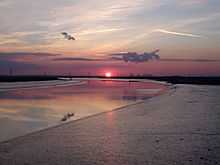The Swale

The Swale is a strip of sea separating North Kent from the Isle of Sheppey. The Swale was originally part of a river valley facing eastwards. As sea-levels rose, water occupied the whole length of the valley, dividing today's Isle of Sheppey from the mainland. The Swale forms both a National Nature Reserve and a Special Protection Area.
History

The name "Swale" is Old English in origin, and is believed to mean "swirling, rushing river", or "rushing water".[1] The Swale was originally part of a river. Prior to the formation of the English Channel in about 6500 BC, the eastern coast of Great Britain extended much further into the area of the present-day North Sea, and the Isle of Sheppey formed part of mainland Britain. The channel now occupied by the Swale comprised a river valley facing eastwards. As sea-levels rose, water occupied the whole length of the valley, dividing today's Isle of Sheppey from the mainland.
When the Romans arrived in Britain, the Swale extended much wider than it does today, with one part of the Isle of Sheppey — now called the Isle of Harty — a separate island. The Isle of Harty is no longer separate but the marshlands now gradually filling the channel delineate it. The channel needs constant dredging to allow use of the busy waterway.
The Swale is crossed at its western end by two bridges: the Kingsferry Bridge and the later Sheppey Crossing.
Nature


The Swale forms both a National Nature Reserve and a Special Protection Area: the eel grass, Ray's knotgrass, white seakale, glassworts and golden samphire support rare and uncommon migrant butterflies and moths, including the Essex emerald, the ground lackey, the clouded yellow butterfly and rare hawk-moths. Since 1968, it has also been a Site of Special Scientific Interest.[2]
Birds
The Swale notably provides habitats for the following birds:
- Avocet Recurvirostra avosetta at least 17 percent of Great Britain's breeding population
- Marsh Harrier Circus aeruginosus at least 15 percent of Great Britain's breeding population
- Mediterranean Gull Larus melanocephalus
- Bar-tailed Godwit Limosa lapponica
- Eurasian Golden Plover Pluvialis apricaria
- Hen Harrier Circus cyaneus
- Ringed Plover Charadrius hiaticula
- Black-tailed Godwit Limosa limosa islandica
- Grey Plover Pluvialis squatarola
- Knot Calidris canutus
- Pintail Anas acuta
- Common Redshank Tringa totanus
- Shoveler Anas clypeata
References
- ↑ Ekwall, Eilert (1960), The Concise Oxford Dictionary of English Place-Names (4th ed.), Oxford: OUP, p. 455, ISBN 978-0-19-869103-7. Mills, A. D. (1998), A Dictionary of English Place-Names (2nd ed.), Oxford: OUP, p. 335. While Ekwall takes the origin of this name to be identical with that of the Yorkshire river, Mills says it is "probably identical".
- ↑ "SSSI The Swale". www.sssi.naturalengland.org.uk. 1968. Retrieved 12 November 2013.
External links
| Wikimedia Commons has media related to The Swale. |
- English Nature page
- Description of Special Protection Area
- Map sources for grid reference TQ999666
Coordinates: 51°21′48″N 0°52′12″E / 51.36328°N 0.87008°E